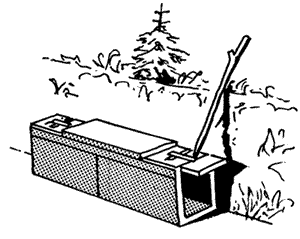-
-
-
-
-
-
-
-
-
-
-
-
-
-
-
-
-
-
-
-
-
-
-
-
-
-
-
|
EUROPEAN MINK, MUSTELA LUTREOLA LINNAEUS
1761,
CAPTIVE BREEDING AND HUSBANDRY PROTOCOL
Tiit Maran & Paul Robinson
EUROPEAN MINK CONSERVATION & BREEDING COMMITTEE
&
TALLINN ZOOLOGICAL GARDENS
PALDISKI ROAD 145, EE0035 TALLINN
ESTONIA
TALLINN - 1996
|
-
A. Introduction 
The European mink is one of the most critically
endangered carnivores in Europe and is in need of urgent conservation
action. The general decline of the species has been alarmingly
rapid in the last fifty years and is thought to be due to a number
of anthropogenic factors including habitat loss, pollution, hunting
& trapping and the introduction of the more robust and opportunistic
American mink. Nearly all known wild populations are near to extinction
and there is little hope for the survival of the species without
intensive protective and management programmes, both in the wild
and captivity. Until more is known about the species' biology
and ecology, effective conservation measures in the wild are limited.
Thus, placing an ever increasing importance on a co-ordinated
captive conservation programme as part of an overall conservation
strategy to aid the species recovery.
Several attempts to breed the European mink in captivity have
been made during recent decades; for commercial, scientific research
and conservation reasons. Unfortunately the results of these attempts
have not always been successful(for more details see Maran T.
1994: Studbook for the European mink,Mustela lutreola Linnaeus,
1761, vol.1). However, these projects have provided a great deal
of valuable knowledge about the captive management of the species.
Furthermore, a lot of useful information applicable to the European
mink has been accumulated by several institutions and experts
concerned with the maintenance of other mustelid species in captivity
(e.g. Black-footed ferret, European otter).
This first edition of the guidelines integrates the knowledge
from several sources:
- knowledge about keeping the European mink gained at Tallinn
Zoo.
- an enormous amount of data, ideas and advice was received
from the Black-footed ferret programme in the United States
of America.
- information derived from the Black-footed ferret captive propagation
protocol at the Metro Toronto Zoo, Canada.
- other information was taken from various European Endangered
Species Programme (EEP) husbandry guidelines, particularly the
EEP Guidelines for otter.
As the European mink is highly endangered, every
single individual is of vital importance to the conservation of
the species and must therefore be handled with utmost care and
in the safest possible way. Therefore, the various protocols set
out in these guidelines must be stringently adhered to wherever
possible. However, there will always be a need to improve our
captive husbandry that will necessitate some modification and
experimentation to determine more effective management techniques.
Although this may appear to be in direct contravention of each
other, adoption of these two approaches(as indicated below)will
ensure best practices in a continuous and evolving programme:
- the protocols must be rigorously adopted providing uniformity
for all holding facilities to ensure maximum success, based
on current knowledge and experience.
- the protocols must incorporate a degree of flexibility to
encourage improvements in the quality of the programme and implementation
of new ideas.
To achieve this goal all the participants must follow the protocol
and, where improvements are proposed, permission must be first
sought from the species co-ordinator, and thereafter, where necessary,
with the European Mink Conservation & Breeding Committee (EMCC).
If no justifiable objection is found the proposer will be encouraged
to implement the proposed new or improved technique(s) and, based
on its success, it will thereafter be incorporated into the guidelines.
The guidelines places an emphasis on maintaining the European
mink in large numbers held in off-show breeding facilities. However,
details of facilities on view to the visiting public in zoos and
wildlife parks, are also discussed.
The current guidelines should not be seen as a definitive or final
document, but as an evolving document where it will be subject
to continuous change in the course of improving the captive conservation
programme. Any comments or constructive criticism about the guidelines
are welcomed.
The authors would like to thank and acknowledge the assistance
of Leif Blomqvist from Helsinki Zoo and Mati Kaal from Tallinn
Zoo in compiling the guidelines. We are grateful to the Societa
Zoologica La Torbiera and to the British Government Darwin Initiative
for financial support.
B. Staffing 
Every breeding facility should designate one member of
the senior staff who is fully responsible to the EMCC for breeding
and keeping of European mink. This person should preferably also
be the contact person for the EMCC. One (or more) full-time mink
keeper(s) will be responsible for the day to day care of the mink
and who will report to the designated EMCC contact. Following
current guidelines the number of keepers necessary to provide
adequate cover at all times, especially during the breeding season,
days off and holiday periods must be determined, along with their
daily routine.
C. Disease Prevention Control 
1. Other animals
Other animals (i.e. feral cats) should be kept away from the vicinity
of the European mink facility. Live-traps should be maintained
around the surrounding fence and trapped animals removed immediately
on inspection. In addition an electric fence may be used to accompany
the exterior fence to discourage unwanted animals climbing into
the enclosed area.

Figure 1.
2. Other precautions
Excessive noise or uncontrolled artificial light could be detrimental
to the animals well-being, particularly during the breeding season
(March - May), parturition and the initial rearing period of kits
(late-May to late-July). Therefore the immediate area surrounding
European mink facility must be kept as private as possible.
Next

|